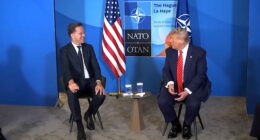WE ARE 100% INDEPENDENT AND READER-FUNDED. FOR A GUARANTEED AD-FREE EXPERIENCE AND TO SUPPORT REAL NEWS, PLEASE SIGN UP HERE, TODAY.
PULSE POINTS
❓WHAT HAPPENED: Federal Reserve Chairman Jerome Powell faced bipartisan pressure from House Democrats and House Republicans to begin cutting interest rates during a Tuesday hearing on Capitol Hill.
👤WHO WAS INVOLVED: Democrat and Republican members of the House Financial Services Committee, Federal Reserve Chairman Jerome Powell, President Donald J. Trump, and Federal Reserve Board of Governors members Christopher Waller and Michelle Bowman.
📍WHEN & WHERE: Powell testified before the House Financial Services Committee on Tuesday, June 24, 2025.
💬KEY QUOTE: “From our side, we’d love to see the rates go down,” said Congressman Juan Vargas (D-CA), adding: “I know a number of my colleagues on the other side would love to see the rates go down. I think it’s pretty unanimous.”
🎯IMPACT: With President Trump, GOP and Democrat lawmakers, and Federal Reserve governors increasingly opposed to Powell’s refusal to cut rates, he may be forced to begin climbing down from his position.
IN FULL
Federal Reserve Chairman Jerome Powell is facing mounting pressure both internally at the central bank and externally from the White House and a bipartisan coalition of lawmakers on Capitol Hill to begin reducing U.S. interest rates. Appearing before Congress on Tuesday, Powell was peppered by House Republicans and Democrats alike to explain his reasoning for not moving to reduce the cost of borrowing.
“From our side, we’d love to see the rates go down,” Congressman Juan Vargas (D-CA) told the Fed chairman during a House Financial Services Committee hearing on Tuesday. The California Democrat added: “I know a number of my colleagues on the other side would love to see the rates go down. I think it’s pretty unanimous.”
Just before the hearing, President Donald J. Trump urged lawmakers to grill Powell, posting on Truth Social: “I hope Congress really works this very dumb, hardheaded person, over.”
The bipartisan pressure faced by Powell was compounded in recent days, which saw two members of the Federal Reserve’s Board of Governors, who sit on the rate-setting Federal Open Market Committee (FOMC), announce their support for the central bank to begin cutting rates in July. On Friday, Federal Reserve Governor Christopher Waller acknowledged that fears over President Trump’s tariffs reigniting inflation were overblown. “I think we’re in the position that we could do this as early as July,” Waller stated, adding: “That would be my view, whether the committee would go along with it or not.”
Waller was joined on Monday by his fellow Fed governor and FOMC member, Michelle Bowman, who echoed her colleague. “It is likely that the impact of tariffs on inflation may take longer, be more delayed, and have a smaller effect than initially expected,” Bowman said in a speech at a research conference in Prague. She added: “Should inflation pressures remain contained, I would support lowering the policy rate as soon as our next meeting.”
Despite increasing internal and external pressure on Powell to slash rates, the Federal Reserve chairman remains obstinate. “As long as the economy’s strong, we can take a little bit of a pause,” Powell told House lawmakers in response to their push for a July rate cut. While the central bank chief acknowledged that the hard data suggests he should have continued reducing rates after the Fed’s last cut in December, Powell—repeating a mantra he has stated for months—insisted: “The difference, of course, is at this time, all forecasters are expecting pretty soon, that some significant inflation will show up from tariffs.”
However, there has been no evidence of a resurgence of inflation due to the tariffs imposed by the Trump White House. In fact, as Trump’s Treasury Secretary Scott Bessent has noted, the tariffs may actually be having a deflationary effect, which should—under normal circumstances—spur the Federal Reserve to reduce interest rates.
Join Pulse+ to comment below, and receive exclusive e-mail analyses.
show less








